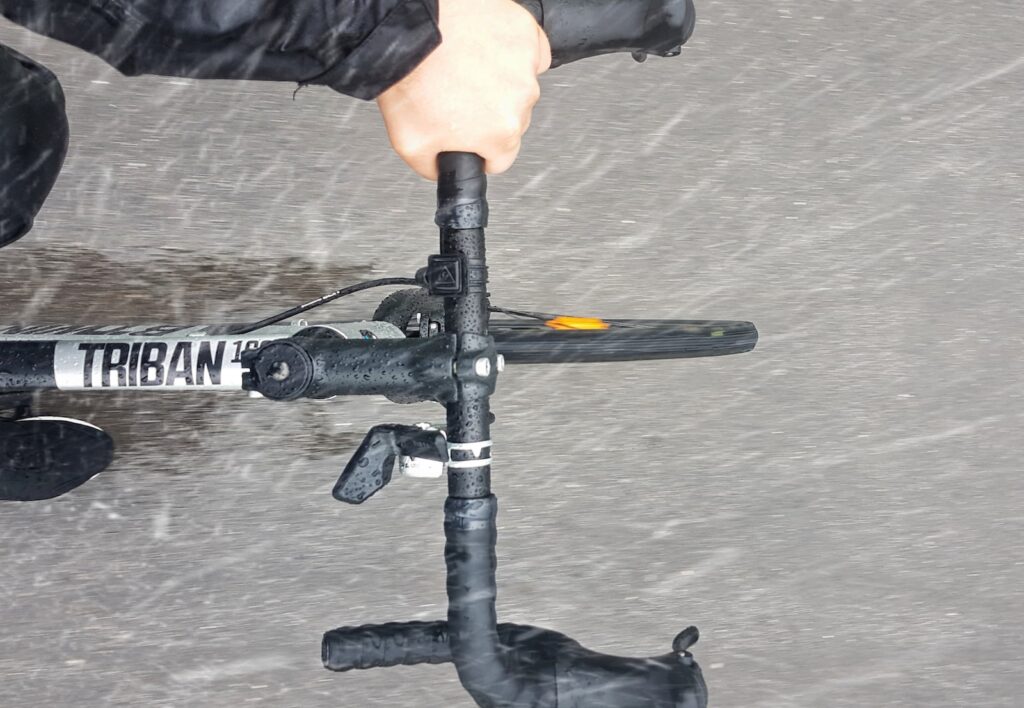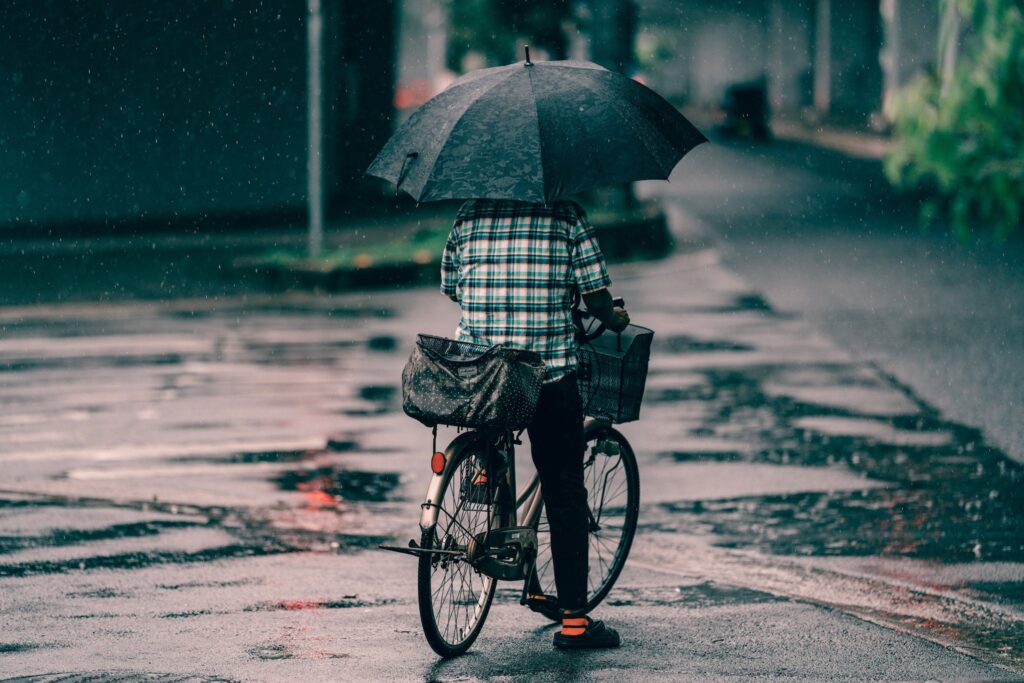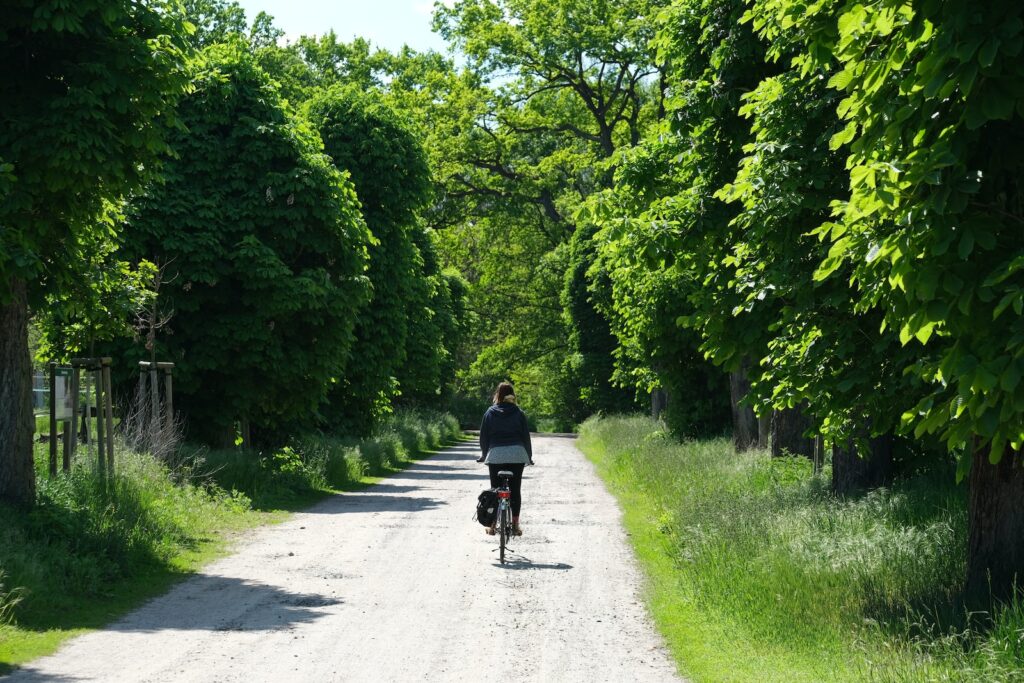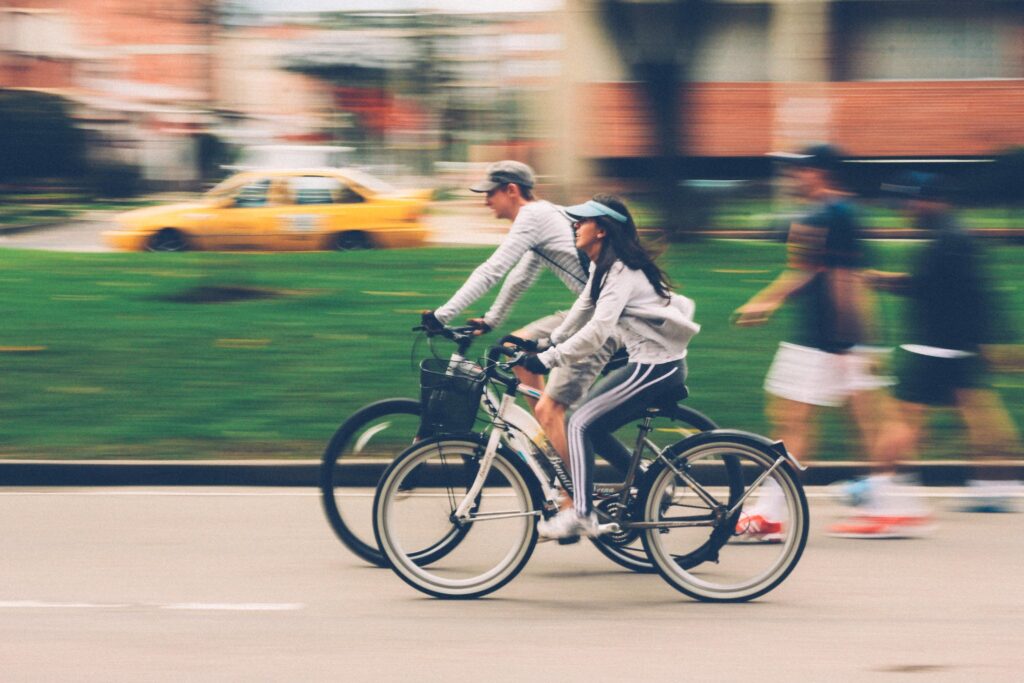For several sunny days in a row, every morning was the same. I’d slowly sip my coffee, bask in the golden glow of the sun, and only then, with no real rush, would I hop on my bike.
On this particular day, however, I took my time over breakfast, feeling no urgency to check the weather. After all, hadn’t the last few days been nothing but blue skies? As I stepped out the door, though, I was greeted with an abrupt downpour. My watch ticked menacingly, reminding me of the train I couldn’t miss. I did have a jacket, but as I surveyed my attire, one thought prevailed: my jeans. The impending sensation of waterlogged denim clinging to my legs was one I dreaded, and the thought of spending an entire day in damp jeans was worse.
The unpredictable nature of rain can be a challenge for many bike commuters. But with years under my belt of bike commuting come rain or shine, I’ve garnered a wealth of tips and insights to ensure not only safety but comfort and efficiency too.
Bike commuting in the rain might seem intimidating, but armed with the right gear and mindset, those stormy days can turn into some of your most rewarding rides. Safety is paramount, especially when visibility is compromised and roads are slick. But beyond safety, the right equipment can transform a wet ride from a soggy ordeal to a refreshing journey.
Table of Contents
Understanding Bike Commuting in the Rain

As a bike commuter, I know how important it is to be prepared for all types of weather conditions. Rainy days can be challenging, but with the right gear and preparation, bike commuting in the rain can be a safe and almost enjoyable experience.
When it comes to bike commuting in rainy weather, it’s important to understand the challenges that come with it. Rain can make the roads slippery, reduce visibility, and increase the risk of accidents. As a result, it’s important to take extra precautions when biking in the rain.
One of the most important things to consider when bike commuting in the rain is the right gear. Investing in waterproof clothing, such as a rain jacket, pants, and shoe covers, can help keep you dry and comfortable during your commute. Additionally, wearing bright and reflective clothing can help increase your visibility to drivers on the road.
Another important factor to consider when bike commuting in the rain is your bike itself. Making sure your brakes are in good condition and your tires have good traction can help reduce the risk of accidents. Additionally, adding fenders to your bike can help prevent water from splashing up onto you and your bike, keeping you dry and comfortable during your commute.
Finally, it’s important to plan your route carefully when bike commuting in the rain. Avoiding roads with heavy traffic and standing water can help reduce the risk of accidents and keep you safe during your commute. Additionally, leaving extra time for your commute can help reduce stress and ensure you arrive at your destination safely and on time.
Preparation for Rainy Commutes
When it comes to bike commuting in the rain, preparation is key to ensure a safe and enjoyable ride. Here are some tips on how to prepare for a rainy commute:
Prepare Your Bike
Before heading out in the rain, it’s important to make sure your bike is in good condition. Check that your tires are properly inflated and have enough tread for wet conditions. If you have disc brakes, make sure they are working properly and not making any strange noises. Installing mudguards or fenders can also help keep you and your bike dry.
Wear Waterproof Gear
Investing in waterproof gear can make all the difference in a rainy commute. A waterproof jacket and pants can keep you dry and comfortable, while overshoes or winter shoe covers can protect your feet from getting wet. It’s also important to wear a helmet with a visor or cycling cap to keep rain out of your eyes.
Use Bike Lights
In rainy conditions, visibility can be reduced. Using bike lights can help you stay visible to other road users. Make sure your lights are fully charged and working properly before heading out.
Pack a Change of Clothes
Even with waterproof gear, it’s possible to get wet during a rainy commute. Packing a change of clothes can ensure you stay dry and comfortable throughout the day.
Check the Weather Forecast
Checking the weather forecast can help you prepare for a rainy commute. If rain is expected, plan your route accordingly and give yourself extra time to get to your destination.
Choosing the Right Gear
Bike commuting in the rain can be challenging, but with the right gear, it can be a pleasant experience. Here are some essential items to consider when choosing the right gear for your rainy-day commute.
Waterproof Clothing
On one of those unpredictable rainy days, when the sky opens up just as you’re about to ride, having the right gear becomes critical. At the forefront of this battle against wetness is the need for waterproof clothing. It isn’t just about staying dry; it’s about ensuring that your ride is comfortable, even when the heavens are pouring.
A robust waterproof jacket is your first line of defense. Paired with waterproof pants, they shield you from the relentless drizzle or an unexpected downpour. But it’s not just about repelling water. You’ll want to ensure that your clothing allows your skin to breathe. There’s nothing more uncomfortable than feeling trapped in a sweaty cocoon while battling the rain. Therefore, materials that offer breathability are crucial. Consider base layers made of merino wool – a material celebrated for its warmth and its impressive ability to wick away moisture, ensuring you remain cozy without being drenched in sweat.
Beyond just the basics, there are other essential accessories to enhance your rain-ready ensemble. Overshoes and cycling over pants are fantastic additions to keep your feet and lower legs bone-dry. Think of them as the protective fortress for the areas most exposed to splashes and puddles. And for those who brave the colder climates, winter shoe covers are not just recommended, but essential. They’re investments that pay dividends in warmth and comfort.
And a word to the wise: avoid jeans and denim like the plague on rainy days. While stylish and casual, they are, unfortunately, rain’s best friend. Once wet, denim becomes heavy, chafes the skin, and takes an agonizingly long time to dry. You might just find yourself spending hours in clammy discomfort, yearning for the warmth of dry clothing. Been there, done that.
Safety Equipment
Safety should always be a top priority when biking, and even more so when biking in the rain. Make sure your bike is equipped with reflectors and lights, especially if you are commuting during the early morning or evening hours. A taillight is particularly important to make sure you are visible to cars behind you.
A waterproof helmet cover is also a great investment to keep your head dry and ensure your helmet is visible to others on the road. A reflective vest is also a great option to increase visibility.
Additional Gear
Biking in the rain can take a toll on your bike, so it’s important to make sure it’s well-maintained. Fenders or mudguards are essential to prevent water and mud from splashing onto you and your bike. It’s also important to regularly clean and lubricate your bike chain to prevent rust and corrosion.
Investing in a set of waterproof gloves is also a great way to keep your hands dry and maintain a good grip on your handlebars.
Safety Measures for Wet Weather Commuting

As a bike commuter, riding in the rain can be a challenging and sometimes dangerous experience. Here are some safety measures that I take to ensure a safe and enjoyable ride in wet weather conditions.
Visibility
One of the most important safety measures for wet weather commuting is ensuring that you are visible to other road users. Wearing bright or reflective clothing can help make you more visible, especially in low-light conditions. Adding reflective tape to your bike and gear can also help increase your visibility.
Puddles
Puddles can be a hazard for bike commuters in the rain. It’s important to avoid riding through puddles whenever possible, as they can hide hazards such as potholes or debris. If you must ride through a puddle, slow down and try to ride in a straight line to avoid losing control.
Painted Lines and Metal Surfaces
Painted lines and metal surfaces can become extremely slippery in wet weather conditions. It’s important to be cautious when riding over these surfaces, as they can cause your bike to slide out from under you.
I remember a chilling incident involving a friend who didn’t anticipate just how treacherous wet-painted lines could be. During a rainy day, she unknowingly rode over one, and, to our collective horror, his bike slid right from beneath him, leading to a significant accident.
Try to avoid turning or braking suddenly on these surfaces, and maintain a steady pace.
Hand Signals
Hand signals are an important part of safe bike commuting, especially in wet weather conditions. It’s important to use hand signals to communicate your intentions to other road users, especially when visibility is reduced. Make sure to signal early and clearly, and always check behind you before making a turn.
Motorists
In wet weather conditions, motorists may have reduced visibility and may not be able to see you as well as they would on a clear day. It’s important to be extra cautious when riding near cars and to assume that they may not see you. Stay alert and be prepared to take evasive action if necessary.
Riding Technique
Riding technique is an important part of safe bike commuting in wet weather conditions. It’s important to maintain a steady pace and avoid sudden movements, as these can cause your bike to slide out from under you. Try to ride in a straight line as much as possible, and avoid making sudden turns or braking.
Traffic Congestion
Traffic congestion can be especially hazardous for bike commuters in wet weather conditions. It’s important to be extra cautious when riding in heavy traffic and to stay alert for sudden stops or lane changes by other road users. Try to maintain a safe distance from other vehicles, and be prepared to take evasive action if necessary.
By following these safety measures, I can enjoy a safe and comfortable ride in wet weather conditions. Remember to always ride defensively and be prepared for the unexpected.
Comfort and Hygiene Considerations

When bike commuting in the rain, it’s important to consider both comfort and hygiene. Here are some tips to help you stay comfortable and clean during your wet commute.
Clothing
As mentioned before, wearing breathable and waterproof clothing is essential for staying comfortable during your ride. Look for rain jackets and pants with vents to help regulate your body temperature and prevent sweating. Additionally, shoe covers can help keep your feet dry, and gloves can protect your hands from the cold and wet.
Hygiene
Riding in the rain can be dirty and messy, but there are steps you can take to stay clean and hygienic. Consider bringing a change of clothes to work, and use wet wipes or a towel to dry off and freshen up before changing. It’s also a good idea to bring a plastic bag to store your wet clothes in.
Conclusion
Biking in the rain can be challenging, but with the right preparation and techniques, it can be a safe and enjoyable experience. Throughout this article, I have shared tips and tricks for successful bike commuting in the rain. Here is a summary of the key takeaways:
- Check the weather forecast before heading out to ensure you are prepared for the conditions.
- Dress appropriately by wearing waterproof and breathable clothing. Consider wearing bright or reflective clothing to increase visibility.
- Use fenders and mudguards to keep water from splashing onto you and your bike.
- Ensure good visibility with lights and reflectors, especially when visibility is reduced due to rain or fog.
- Adjust your riding style to accommodate the wet conditions. Slow down, brake earlier, and avoid sudden movements.
- Avoid riding through standing water or areas with poor drainage to prevent hydroplaning.
- Maintain your bike by keeping it clean and lubricated to prevent rust and damage from the rain.
Following these tips can make your bike commute in the rain safer and more enjoyable. Remember to always prioritize safety and use common sense when riding in wet conditions.








